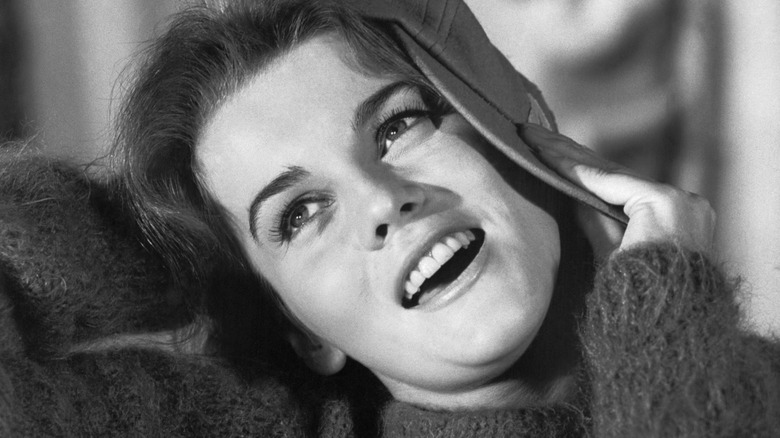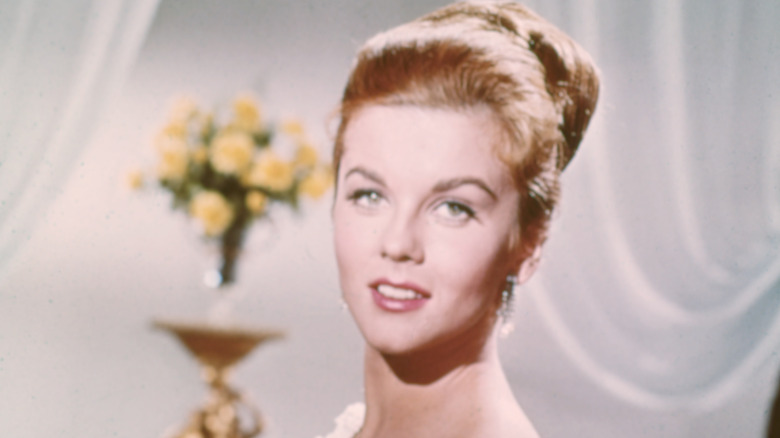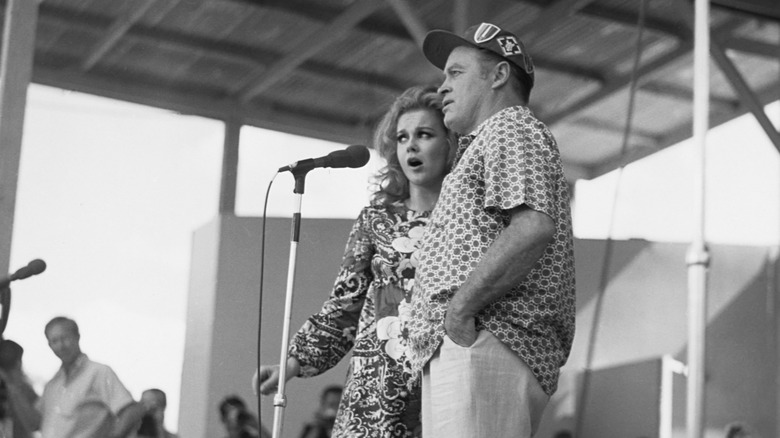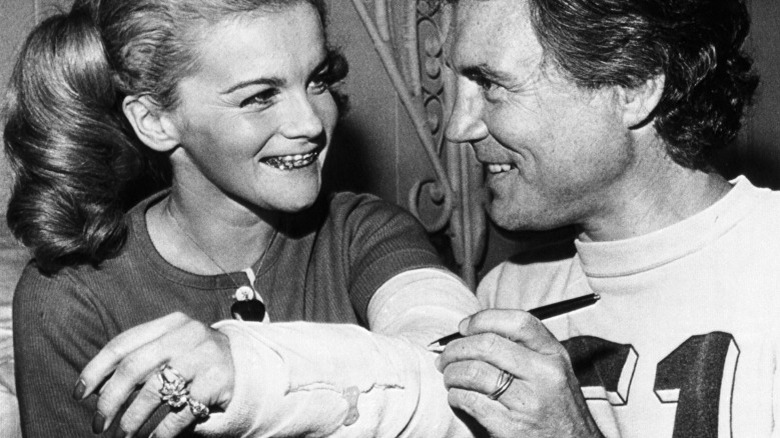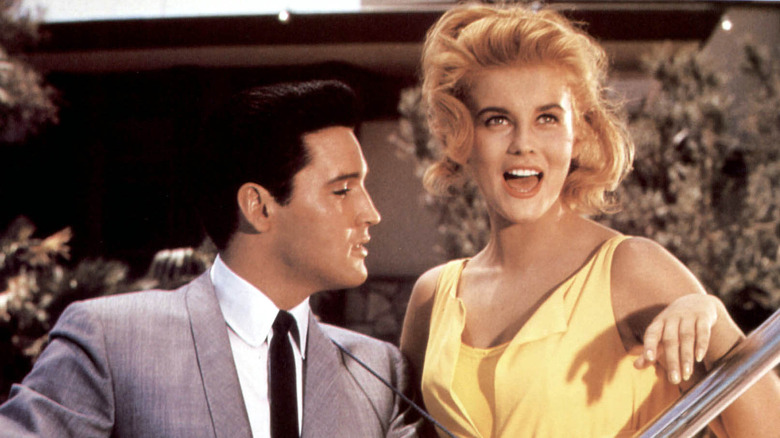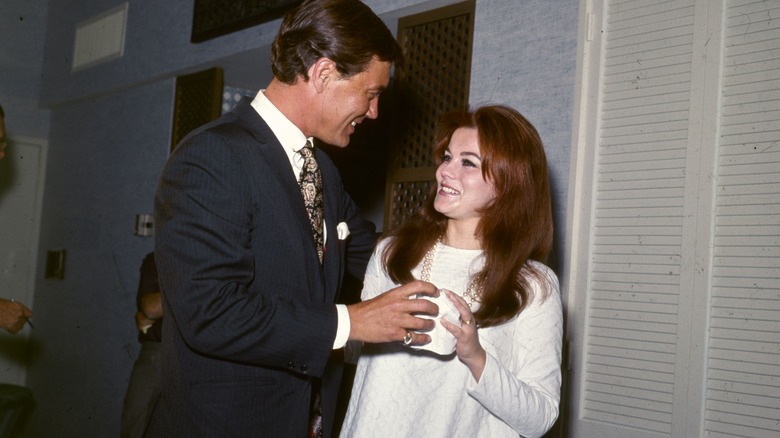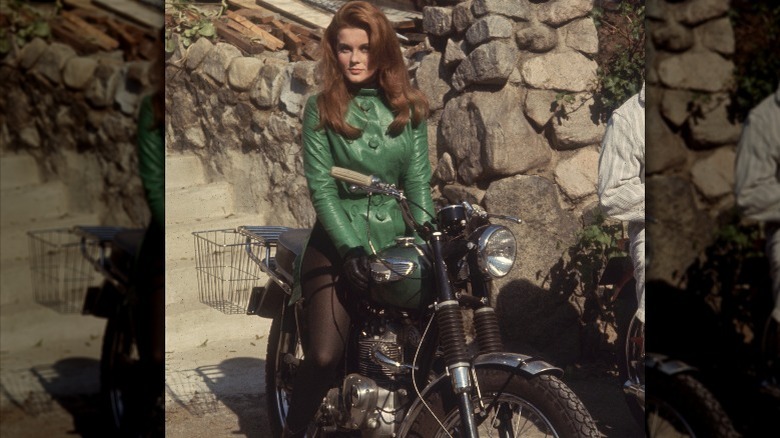Tragic Details About Ann-Margret
Ann-Margret (real name Ann-Margret Olsson) is a Hollywood legend. Born on April 28, 1941, Ann-Margret spent her early years in her native Sweden before she moved to the United States. She launched her performance career while still in her teens and was performing with a band when comedian George Burns discovered her. She landed her first role in 1961's "Pocketful of Miracles," which starred veteran actress Bette Davis. Her role as Kim McAfee in the film adaptation of the musical "Bye Bye Birdie" in 1963 brought her to wider acclaim, and she quickly became a leading actress and recording artist who was considered to be one of the most glamorous bombshells in the industry.
From there, she went on to star alongside Elvis Presley in "Viva Las Vegas," inspired the "Flintstones" character Ann-Margrock, and — a decade after making her film debut — transformed her screen-siren image and established herself as a serious dramatic actress in 1971's "Carnal Knowledge." Ann-Margret is still working today with no plans to retire — she released a new album at the age of 81.
But her charmed career didn't come without its drawbacks.
Ann-Margret's entire life was uprooted when she was a little girl
Ann-Margret's father, Carl Olsson, moved from Sweden to the United States when she was just 1 year old, leaving her and her mother, Anna Olsson, behind as he worried about them moving overseas at the time due to the hazards of World War II. The family was finally reunited when Ann-Margret was 6 years old and she and her mother moved to the U.S. to join Carl. But living in a new country wasn't without its challenges. Not only had the move uprooted her life, but she was also in a country where she didn't speak the language.
The future actress was undaunted, though, telling reporters (via The Chicago Tribune), ”I just studied harder because I didn't want to seem different from anyone else. What happened because of that — I actually won a few spelling bees."
Even though she learned to acclimate to her new life, Ann-Margret never lost touch with her Swedish roots, telling Wonderlust, "Of course, I identify as Swedish. Of course!"
She experienced groundfire in Vietnam
While Ann-Margret never served in the military, she still found herself caught in a crossfire during the Vietnam War. She performed with the USO for American troops stationed in Vietnam twice, once in 1966 and once in 1968, and considers it an important part of her career. She embarked on her first tour in Vietnam after soldiers signed a petition asking her to come. In her autobiography, "My Story" (via the USO website), she said she "regarded the trip as a moral responsibility, something I owed to the soldiers and to America. ... Nothing could deter me."
That tour brought her to different locations around Vietnam, and she often performed to the sound of gunfire in the background. On one occasion, she was flying in a helicopter heading to a new location, when fighting broke out beneath her. While many (if not most) people would have been terrified, Ann-Margret recounted feeling protected by soldiers who formed a human shield around her. "I was never scared in 1966 or 1968," she said.
Ann-Margret also doesn't view what she did as anything extraordinary but as her duty. To her, the true heroes are the troops. "For anybody who has been in combat, we will never know what they have seen and heard," she told the USO. "All I do is sing, dance, and act. That's it. They are the ones making all the sacrifices and are incredible patriots."
Ann-Margret suffered a near-fatal fall
Longtime fans of Ann-Margret know that she has suffered more than one severe accident over the years. Perhaps the most famous of these accidents was her 1972 fall from a 22-foot platform at a Lake Tahoe casino. She was supposed to descend to the stage via the platform, but the setup was changed unexpectedly, leaving the platform unstable. Ann-Margret suffered a number of injuries and spent three days in a coma, but it could have been much worse. "My face was collapsed and swollen beyond recognition," she wrote in her autobiography, "My Story" (via The Washington Post). "Numerous bones in my face were either broken or fractured. My jaw was broken in two places. My left arm was broken. ... There was a huge gash on my knee, which had split open, like a splattered tomato. The doctors feared I'd never dance again — if I survived."
Thankfully, Ann-Margret pulled through and her career was unharmed — she returned to performing just a few months later. She also managed to avoid severe facial scarring because her husband — who stole a plane when a commercial flight wasn't available to rush him to her side — pushed for an experimental procedure.
An accident on the set of Tommy left her with 27 stitches
Another accident happened on the set of the 1975 musical "Tommy," based on a rock opera album by The Who. The often surreal film features Ann-Margret singing and dancing, and one memorable sequence shows her shattering a champagne bottle against a TV screen, releasing a flood of bubbles that soon turns into a torrent of baked beans.
The scene was messy to film and took a full day of shooting, but having to smell beans for hours on end wasn't the worst of it. Ann-Margret suffered an injury during the scene that resulted in her being rushed to the hospital. "In the scene, I'm just going crazy and whacking my way through these bubbles, and then suddenly I hit something," she recalled in a discussion with George Hamilton in Interview. "They had taken away all of the glass and the props, but they had forgotten about the glass in the TV set. So I hit that with a thud, and then I start to see pink appearing in the soap bubbles, which resulted in 27 stitches."
While that incident would have been enough to traumatize anyone, Ann-Margret went back to filming the following day with her injured arm hidden by a desk — she did get a break a few days later, though. Surprisingly, the incident didn't put her off beans. "It was quite an experience," she told The Hollywood Reporter. "And I'm proud of the work that I did."
She had an ill-fated romance with Elvis Presley
While many people are familiar with the truth about Elvis and Priscilla Presley's relationship, the details of the relationship between Elvis and Ann-Margret aren't as widely known. Part of that is Ann-Margret's doing, as she was reluctant to divulge details about their connection; when asked about the Elvis biography Albert Goldman published in the '80s, Ann-Margret told Roger Ebert, "I absolutely refuse to discuss the subject. I find that book disgusting." The book blasted Presley, criticizing everything from his vocal skills to his romantic life.
The pair were involved for a year, falling for each other on the set of "Viva Las Vegas." Ann-Margret later wrote in her autobiography, "My Story," (via The Washington Post), "We both felt a current, an electricity that went through us. It would become a force we couldn't control." While things didn't work out — Presley was involved with Priscilla at the time, which Ann-Margret hinted led her to break things off — their flame was never fully extinguished. Presley continued to send flowers to Ann-Margret until his death in 1977. Ann-Margret attended his funeral, and years after his death, she visited his father, Vernon.
"I will never recover from Elvis' death," Ann-Margret wrote in her 1994 book (via CheatSheet). "He is a part of me ... It's rare to have such a friend as Elvis, rare to have such a soulmate."
Her husband was diagnosed with a debilitating illness
Ann-Margret moved on from her heartbreak over her split from Elvis Presley, marrying fellow actor Roger Smith in 1967. She was 26 and he was 34. Smith, who starred in the TV show "77 Sunset Strip," never reached Ann-Margret's level of fame, but he was happy to manage her career as her star continued to rise. The two were deeply in love, with Ann-Margret telling The New York Times, "The man that I married is the man I knew I was going to marry on the third date."
Their life took a difficult turn in the '80s when Smith was diagnosed with myasthenia gravis, a condition that affects nerve impulses and impacted his ability to move. Ann-Margret threw herself into caring for her husband. "Slowly, I became a different woman inside," she wrote in "My Story" (via The Washington Post). "The dependent, shy Ann-Margret slipped away by necessity, and a confident and competent woman came in her place. I could not only sing, act, and dance, but buy stocks and bonds, hire a plumber, and make business decisions about my career. For many women, all this is a given, but for me it was a quiet triumph."
Thankfully, Smith eventually went into remission, and they were able to spend many more happy years together. And, as with many of the other tragic ordeals in her life, Ann-Margret came out on the other end of it a stronger person.
Ann-Margret faced fertility issues
Contrary to her status as a sex symbol, in real life, Ann-Margret is more reserved, even describing herself to The Chicago Tribune as "a prude." After tying the knot with Roger Smith, she longed to start a family with him.
Alas, having a biological child wasn't in the cards for her. Ann-Margret tried to conceive for over a decade and underwent fertility treatment before giving up hopes of having a baby. "The point is, if I am meant to have a child, I will have one," she told McCall's in 1985 (via UPI). 'Whatever my higher power feels is right for me, I will accept. I know this may sound simplistic, but I believe in the serenity prayer: 'God, grant the serenity to accept the things I cannot change, the courage to change the things I can, and the wisdom to know the difference.”
Although the fertility treatments didn't work, Ann-Margret was a loving stepmother to Smith's three children from a previous marriage, jokingly referring to herself as their "wicked stepmother of the west" in Interview. It was clear how much she cared for them, though she refused to divulge details, confirming that she wanted to keep them out of the limelight "for their sake."
The death of Ann-Margret's parents hit her hard
Ann-Margret was very close to her parents, even dropping her last name, Olsson, at the start of her career in order to preemptively keep them out of the spotlight. "I really wanted to protect them from any bad news about me, anything bad that was said," she told "CBS Sunday Morning" (via CBS News).
Her father Carl Olsson, died in 1973 from cancer, and it came as a rough blow to the Hollywood star. "I was his only child and he was my protector," she told The Hollywood Reporter of their relationship. She also shared a special bond with her mother, Anna Olsson, who died in 2001 at the age of 82. Ann-Margret was so distraught that she delayed the recording of the gospel album she was working on, "God Is Love: The Gospel Sessions." When she did head to the studio, her mother was on her mind. "[My mother] was so excited about it and so interested in [the album], so it made me feel good to honor her with it," she told the Los Angeles Times.
Ann-Margret never got over the death of her parents, but her belief in an afterlife keeps her going. "If I thought that I would never see my mother and father again, I couldn't make it. I could not go a step further," she told CBN's Scott Ross.
She dealt with substance abuse for years
As the 1970s wore on, Ann-Margret dealt with an addiction. "The easy thing in Hollywood is to tune out. To drink and use drugs," she once told Roger Ebert. In Ann-Margret's case, the substance abuse was triggered by many things, among them her 1972 fall and her father's death. Over the years, she began to drink more and also abused sleeping pills. "I reached a point where my days and nights blended into one continuous, foggy state of inebriation," she wrote in her autobiography (via Elvis History Blog).
After seeking treatment, Ann-Margret became sober in 1980 and didn't look back. That doesn't mean that being in active recovery has always been easy, though, as she explained in an interview with CBN's Scott Ross. "You never really overcome it," she said. "But I dealt with it. ... I have constantly been dealing with it. ... You always have to be aware of it."
If you or anyone you know needs help with addiction issues, help is available. Visit the Substance Abuse and Mental Health Services Administration website or contact SAMHSA's National Helpline at 1-800-662-HELP (4357).
She once broke several ribs in a motorcycle accident
In spite of the fact that Ann-Margret suffered such horrifying accidents early on in her career, she's still something of a thrill seeker who doesn't shy away from danger. Case in point? Her love of motorcycles. Never mind the time she broke four ribs and a shoulder in an accident, which she explained in an appearance on "Larry King Live" following the crash. "There are two types of motorcycle riders: ones who have had an accident and ones who will," she said.
Sure enough, she remained unfazed and is still an avid motorcycle devotee decades after her 2000 fall. Ann-Margret's ability to keep going no matter the circumstances speaks to her tireless work ethic as well as her fearlessness. As she told Vanity Fair, "I'm just gonna get up on that bike again. I'm going to get up from whatever happened to me. I will get up and go."
Ann-Margret's beloved husband died in 2017
Ann-Margret and Roger Smith were married for 50 years and were, by all accounts, quite happy and devoted to each other. Their long-lasting marriage was a true rarity in Hollywood, where celebrity couplings are often short-lived. Their secret? "It's very simple actually," Ann-Margret told People. "We both want it to work."
After spending most of her life with Smith, Ann-Margret was understandably devastated after he died in 2017. She found ways to cope, though, telling Page Six that one thing that kept her going was a weekly dinner with her friends. She also threw herself into her work, which provided a much-needed distraction. "You're not dead when you reach a certain age," she told Closer Weekly. "You have to keep living and not sit at home and watch TV alone. You have to participate." Since Smith's death, Ann-Margret has appeared in several film and television roles, including a two-episode guest arc on "The Kominsky Method" and the film "Queen Bees."
Of course, she will never forget her husband — no matter how busy she is. Still, she remains hopeful. "She lets herself be sad but also cherishes the years they had together," a source told Closer Weekly. "She believes he is still watching out for her."

